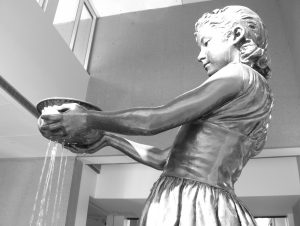
The Little Water Girl. Essay contributed by Portland author Cliff Gallant.
When the renovations to the Portland Public Library were newly completed, I noticed an elderly woman standing in the foyer quietly contemplating the Little Water Girl sculpture, and as I passed by the woman, I heard her whisper the word “precious” to herself. I’m rather fond of the piece myself, so I glanced over caught the woman’s eye and gave her a little smile. She brightened up, took a step towards me, and began to say something, as if she had to tell someone what she was feeling, but instead she just laid her hand on my arm and sighed, as if whatever she said just wouldn’t be enough.
The piece depicts a young girl holding out a cup of cold water to passersby, with the overflowing water falling into a trough at her feet for horses to drink out of. Two wide steps are carved out of the left side of the granite base as an invitation to people to ascend and drink from the cup, and in the rear right corner of the base is a small basin carved out of the granite for birds and dogs to drink from. A most fitting memorial to the woman to whom the sculpture is dedicated, Mrs. M.N. Stevens, of Portland, who was known, as a young girl, and all through her life, for her great love and compassion for her fellow human beings and for all living things.
Lillian Stevens, who was born in 1844 in Dover-Foxcroft as Lillian Ames, was the third national president of the Woman’s Christian Temperance Union, from 1898 to when she died, in 1914, and the Little Water Girl sculpture was given to the City of Portland by the national organization in her honor in 1917. The original sculpture, from which copies were made, was commissioned by the WCTU and created in 1893 by sculptor George E. Wade in his studio in London, England, for the Columbia Exhibition in Jackson Park, Chicago. At the time, the WCTU was involved in a program to place public drinking fountains in cities around the world for the purpose of providing people with “pure drinking water, as an alternative to liquor”, and Little Water Girl sculptures were placed in Chicago, Detroit, and London, England, as well as in Portland.
Although the inscription on the bronze plaque on the base of the Portland piece, which was designed by Portland Architect Frederick Thompson, refers only to her work with the WCTU, Lillian Stevens devoted herself to a wide variety of other humanitarian causes as well, particularly with regards to women’s rights and the welfare of children, and that work stands as her greatest legacy to future generations.
The first “safe house” in the country for abused women and children was founded in Portland, through the efforts of Lillian Stevens. The Temporary Home for Women and Children she founded here served as a model for such institutions nationally and around the world. The coming into being of such institutions was a sign of the new-found recognition that women and children have rights that protect them from abuse by violent husbands and fathers. Only when Lillian Stevens began to question long-standing convention and take appropriate action did desperately needed change begin to occur.
Prison reform, especially with regards to incarcerated women, was another of Lillian Stevens’ passions. In her time there weren’t separate prison for men and women and she saw the great danger to women inherent in that. In a most fitting tribute to the reforms she brought about, when the Maine State Reformatory for Women was established in Hallowell, the first building was named Stevens School in her honor, and is today the main building of Stevens Commons, a mixed-use community center.
Lillian Stevens’ compassion and reform efforts also extended to the welfare of animals. She was especially grieved by the cruel treatment that horses were subject to at a time when they were commonly regarded as beasts of burden unable to feel pain or discomfort. The prevalent belief was that horses, like all other animals, were insentient beings put on this earth to serve man, whether for work or pleasure. Just before Lillian Steven’s passing she was, most fittingly, presented with the highest lifetime achievement award accorded by the Society for the Prevention of Cruelty to Animals.
The Little Water Girl sat in Congress Square from 1917 to 1928, directly across High Street from where the Union Station clock sits today. The piece was well utilized there as a drinking fountain by passersby, as well as a watering trough for horses and a place where dogs and birds could also get a drink, but with the coming of the automobile and the faster pace of life it brought, The Little Water Girl was moved to Deering Oaks, where it sat until the 1940’s, when it was placed in storage after having been vandalized. Repaired and returned to Deering Oaks in 1961, where it remained until 1979, when it was moved to the courtyard of the Portland Public Library. With the renovation of the library in 2010, the piece was moved to its present location in the foyer, where it sits as the gem of the city’s public art collection.
Yes, the woman was right, “precious” it is.
For more about artworks on display at the Library: Art @ PPL
posted: , by Abraham